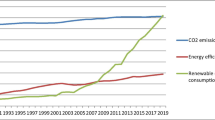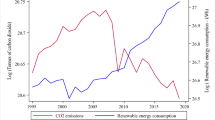Abstract
Japan’s long-term CO2 emission reduction scenarios are assessed with a computable general equilibrium model with recursive dynamics, which was modified in order to assess the effects of renewable energy supply. The period of assessment is from 2000 to 2050 and the increase of gross domestic product per capita was assumed to be 2% per year. The following scenarios in which the level of CO2 emissions in 2050 will be 30% of the level in 1990 or less are proposed: (1) if the renewable energy supply in 2050 is less than the actual potential, an energy intensity improvement of 2.6% per year will bring about a CO2 emission level of 81 MtC in 2050; (2) if the electricity from renewable energy in 2050 can be supplied to the physical potential, and instead of solar heat, 50% more biomass energy can be supplied than the physical potential, the CO2 emission level in 2050 will be 86MtC by achieving a 2.0% per year energy intensity improvement. When the above two scenarios are appropriately combined, the CO2 emission level in 2050 becomes 66MtC. In addition to energy efficiency improvement and renewable energy supply, changes in economic activity such as lower material input and higher labor productivity are also important to achieve the above target.
Similar content being viewed by others
References
Advisory Committee for Energy (2005) Report on forecast of energy supply and demand in 2030 (in Japanese). http://www.meti.go.jp/report/downloadfiles/g50328b01j.pdf. Cited September 2, 2005 Agency for Natural Resources and Energy, Report on energy supply and demand (in Japanese). Research Company of International Trade and Industry, Tokyo
Department of Trade and Industry (2003) Options for a low carbon future. Department of Trade and Industry, Economics paper No. 4, UK
Economic and Social Research Institute (2001) Report on national accounts from 1955 to 1998. Ministry of Finance, Tokyo, Japan
Economic and Social Research Institute, Annual report on national accounts. Ministry of Finance, Tokyo, Japan
German Advisory Council on Global Change (2003) Climate protection strategies for the 21st century. Kyoto and beyond. http://www.wbgu.de/wbgu_sn2003_engl.pdf. Cited September 2, 2005
Humphreys K, Mahasenan M (2002) Toward a sustainable cement industry, substudy 8: climate change. World Business Council for Sustainable Development, Geneva
Intergovernmental Panel on Climate Change (IPCC) (2000) Emissions scenarios. Cambridge University Press, Cambridge
IPCC (2001) Climate change 2001: mitigation. Cambridge University Press, Cambridge
International Iron and Steel Institute (2004) The measure of our sustainability, report of the world steel industry 2004. International Iron and Steel Institute, Brussels
Kainuma M, Matsuoka Y, Morita T (eds) (2002) Climate policy assessment. Springer, Berlin Heidelberg New York
Masui T (2005) Policy evaluations under environmental constraints using a computable general equilibrium model. European Journal of Operational Research 166:843–855
Masui T, Rana A, Matsuoka Y (2002) AIM/material model. In: Kainuma M, Matsuoka Y, Morita T (eds) Climate policy assessment. Springer, Berlin Heidelberg New York, pp 177–196
Matsuoka Y (2005) A level of dangerous climate change and climate stabilization target for developing long-term policies (in Japanese). Environmental Research Quarterly 138:7–16
Ministry of the Environment, Japan (2001) Four socio-economic scenarios in Japan: report on scenario development to reduce greenhouse gas emissions in Japan (in Japanese). Ministry of the Environment, Tokyo, Japan
Ministry of the Environment, Japan (2005) Plan to achieve the Kyoto Protocol (in Japanese). Ministry of the Environment, Tokyo, Japan. http://www.env.go.jp/houdou/gazou/5937/6699/2278.pdf. Cited September 2, 2005
Ministry of the Environment, Sweden (2003) The Swedish climate strategy, summary Government Bill 2001/02:55, Ministry of the Environment, Sweden. http://www.sweden.gov.Se/content/l/c6/02/05/22/bb5baf61.pdf. Cited September 2, 2005
Mission Interministérielle de l’Effet de Serre (2004) Reducing CO2 emission fourfold in France by 2050: introduction to the debate. Mission Interministérielle de l’Effet de Serre, http://www.climnet.org/pubs/1004_France_Factor%204.pdf. Cited September 2, 2005
National Institute of Population and Social Security Research (2002) Population projections for Japan: 2001–2050 (with long-range population projections: 2051–2100) (in Japanese). Health and Welfare Statistics Association, Tokyo
New Energy and Industrial Technology Development Organization (2002) Endowment of renewable energies (in Japanese). http://www.nedo.go.jp/nedata/14fy/14/b/0014b027.pdf. Cited September 2, 2005
Tuinstra W, Berk M, Hisschemöller M, Hordijk L, Metz B, Mol APJ (eds) (2002) Climate options for the long term: final report, volume A. http://www.wau.nl/cool/reports/COOLVolumeAdef.pdf. Cited September 2, 2005
von Weizsäcker E, Lovins A, Lovins H (1997) Factor four: doubling wealth, halving resource use. Earthscan, London
Author information
Authors and Affiliations
About this article
Cite this article
Masui, T., Matsuoka, Y. & Kainuma, M. Long-term CO2 emission reduction scenarios in Japan. Environ Econ Policy Stud 7, 347–366 (2006). https://doi.org/10.1007/BF03354007
Received:
Accepted:
Published:
Issue Date:
DOI: https://doi.org/10.1007/BF03354007




